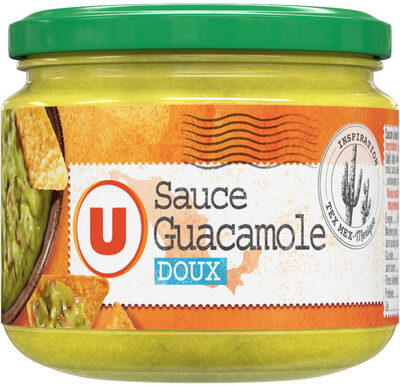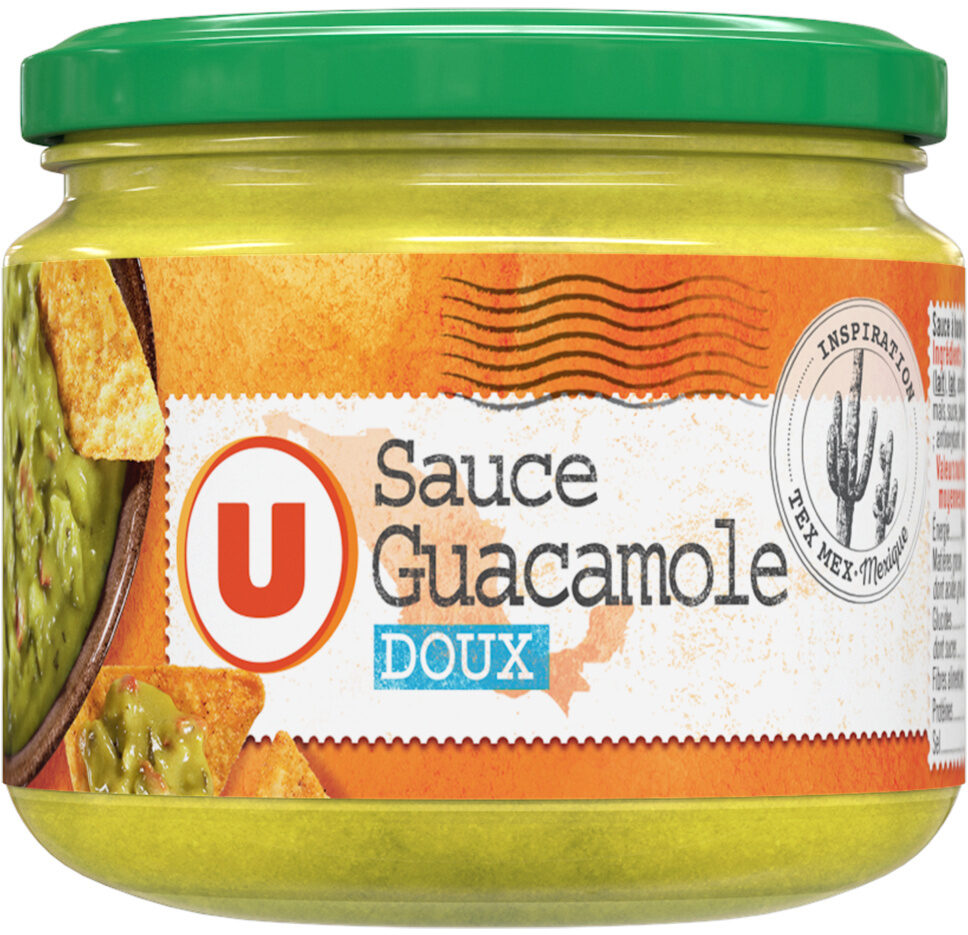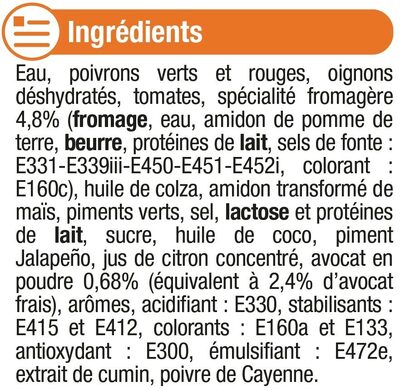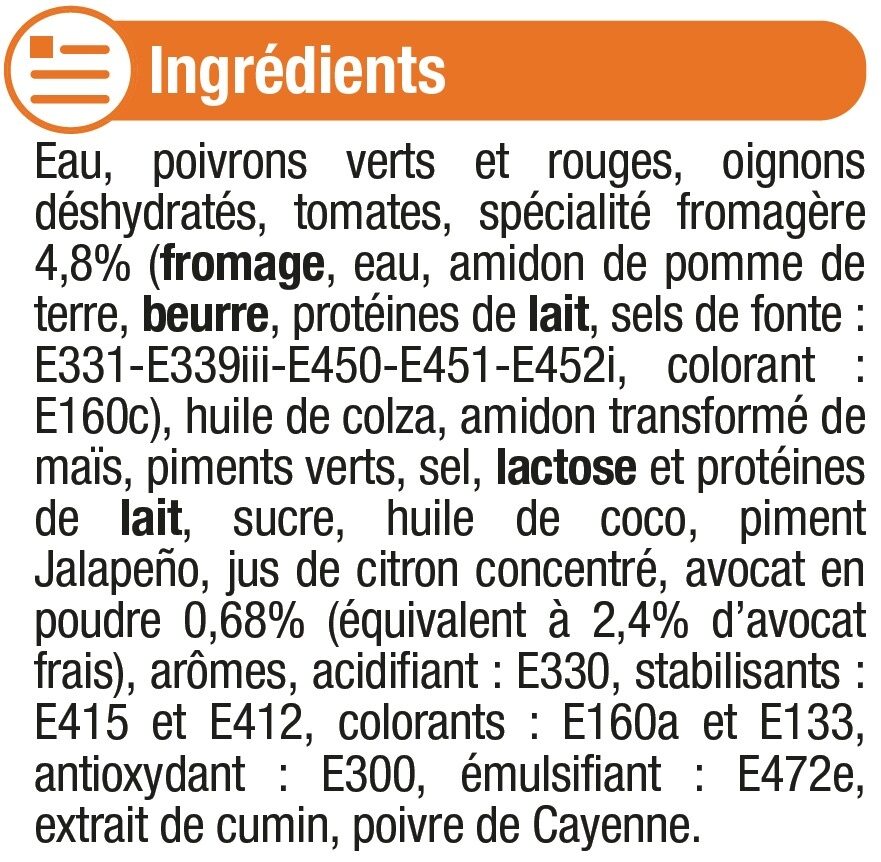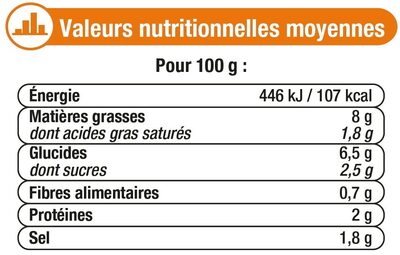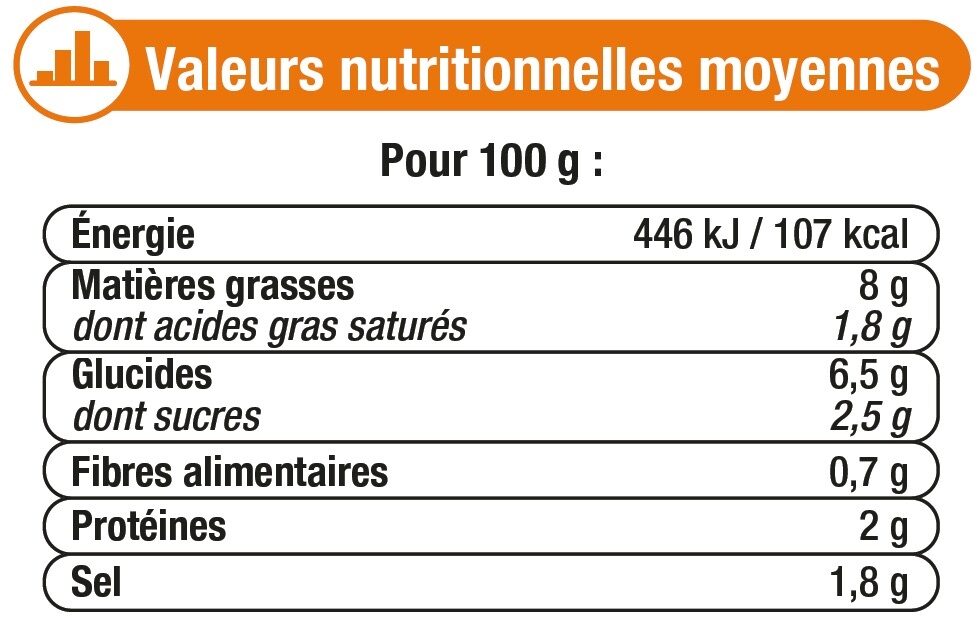Help us make food transparency the norm!
As a non-profit organization, we depend on your donations to continue informing consumers around the world about what they eat.
The food revolution starts with you!
Guacamole - U - 300 g
Guacamole - U - 300 g
This product page is not complete. You can help to complete it by editing it and adding more data from the photos we have, or by taking more photos using the app for Android or iPhone/iPad. Thank you!
×
Some of the data for this product has been provided directly by the manufacturer Système U.
Barcode: 3256220252294 (EAN / EAN-13)
Quantity: 300 g
Packaging: Metal, Glass, Box, Jar
Brands: U
Categories: Plant-based foods and beverages, Plant-based foods, Condiments, Spreads, Plant-based spreads, Sauces, Dips, Guacamoles, Groceries
Labels, certifications, awards:
Green Dot
Manufacturing or processing places: Belgique
Stores: Super U, Magasins U
Countries where sold: France
Matching with your preferences
Health
Ingredients
-
38 ingredients
: Eau, avocat ( 14%), oignon, poivron vert, tomates, MASCARPONE (CRÈME (LAIT), LAIT, acidifiant: acide citrique), CRÈME (LAIT), huile de colza, amidon modifié de maïs, sucre, piment vert, poivron rouge, sel, piments jalapeño, acidifiant: acide lactique - antioxydant: acide ascorbique - jus de citron concentré, épices, émulsifiant: esters monoacétyltartrique et diacétyltartrique des mono - et diglycérides d'acides gras - stabilisants: gomme xanthane, gomme guar - colorant: caroténoïdes - feuille de coriandre, acidifiant: acide citrique - persil, colorant: complexes cuivre-chlorophylles et chlorophyllines - ail en poudre.Allergens: Milk
Food processing
-
Ultra processed foods
Elements that indicate the product is in the 4 - Ultra processed food and drink products group:
- Additive: E140 - Chlorophylls and Chlorophyllins
- Additive: E141 - Copper complexes of chlorophylls and chlorophyllins
- Additive: E14XX - Modified Starch
- Additive: E160 - Carotenoids
- Additive: E412 - Guar gum
- Additive: E415 - Xanthan gum
- Additive: E472e - Mono- and diacetyltartaric acid esters of mono- and diglycerides of fatty acids
- Ingredient: Colour
- Ingredient: Emulsifier
Food products are classified into 4 groups according to their degree of processing:
- Unprocessed or minimally processed foods
- Processed culinary ingredients
- Processed foods
- Ultra processed foods
The determination of the group is based on the category of the product and on the ingredients it contains.
Additives
-
E140 - Chlorophylls and Chlorophyllins
Chlorophyll d: Chlorophyll d is a form of chlorophyll, identified by Harold Strain and Winston Manning in 1943. It is present in cyanobacteria which use energy captured from sunlight for photosynthesis. Chlorophyll d absorbs far-red light, at 710 nm wavelength, just outside the optical range. An organism that contains chlorophyll d is adapted to an environment such as moderately deep water, where it can use far red light for photosynthesis, although there is not a lot of visible light.Source: Wikipedia
-
E140ii - Chlorophyllins
Chlorophyll d: Chlorophyll d is a form of chlorophyll, identified by Harold Strain and Winston Manning in 1943. It is present in cyanobacteria which use energy captured from sunlight for photosynthesis. Chlorophyll d absorbs far-red light, at 710 nm wavelength, just outside the optical range. An organism that contains chlorophyll d is adapted to an environment such as moderately deep water, where it can use far red light for photosynthesis, although there is not a lot of visible light.Source: Wikipedia
-
E270 - Lactic acid
Lactic acid: Lactic acid is an organic compound with the formula CH3CH-OH-COOH. In its solid state, it is white and water-soluble. In its liquid state, it is colorless. It is produced both naturally and synthetically. With a hydroxyl group adjacent to the carboxyl group, lactic acid is classified as an alpha-hydroxy acid -AHA-. In the form of its conjugate base called lactate, it plays a role in several biochemical processes. In solution, it can ionize a proton from the carboxyl group, producing the lactate ion CH3CH-OH-CO−2. Compared to acetic acid, its pKa is 1 unit less, meaning lactic acid deprotonates ten times more easily than acetic acid does. This higher acidity is the consequence of the intramolecular hydrogen bonding between the α-hydroxyl and the carboxylate group. Lactic acid is chiral, consisting of two optical isomers. One is known as L--+--lactic acid or -S--lactic acid and the other, its mirror image, is D--−--lactic acid or -R--lactic acid. A mixture of the two in equal amounts is called DL-lactic acid, or racemic lactic acid. Lactic acid is hygroscopic. DL-lactic acid is miscible with water and with ethanol above its melting point which is around 17 or 18 °C. D-lactic acid and L-lactic acid have a higher melting point. In animals, L-lactate is constantly produced from pyruvate via the enzyme lactate dehydrogenase -LDH- in a process of fermentation during normal metabolism and exercise. It does not increase in concentration until the rate of lactate production exceeds the rate of lactate removal, which is governed by a number of factors, including monocarboxylate transporters, concentration and isoform of LDH, and oxidative capacity of tissues. The concentration of blood lactate is usually 1–2 mM at rest, but can rise to over 20 mM during intense exertion and as high as 25 mM afterward. In addition to other biological roles, L-lactic acid is the primary endogenous agonist of hydroxycarboxylic acid receptor 1 -HCA1-, which is a Gi/o-coupled G protein-coupled receptor -GPCR-.In industry, lactic acid fermentation is performed by lactic acid bacteria, which convert simple carbohydrates such as glucose, sucrose, or galactose to lactic acid. These bacteria can also grow in the mouth; the acid they produce is responsible for the tooth decay known as caries. In medicine, lactate is one of the main components of lactated Ringer's solution and Hartmann's solution. These intravenous fluids consist of sodium and potassium cations along with lactate and chloride anions in solution with distilled water, generally in concentrations isotonic with human blood. It is most commonly used for fluid resuscitation after blood loss due to trauma, surgery, or burns.Source: Wikipedia
-
E330 - Citric acid
Citric acid is a natural organic acid found in citrus fruits such as lemons, oranges, and limes.
It is widely used in the food industry as a flavor enhancer, acidulant, and preservative due to its tart and refreshing taste.
Citric acid is safe for consumption when used in moderation and is considered a generally recognized as safe (GRAS) food additive by regulatory agencies worldwide.
-
E412 - Guar gum
Guar gum (E412) is a natural food additive derived from guar beans.
This white, odorless powder is valued for its remarkable thickening and stabilizing properties, making it a common ingredient in various food products, including sauces, dressings, and ice creams.
When used in moderation, guar gum is considered safe for consumption, with no known adverse health effects.
-
E415 - Xanthan gum
Xanthan gum (E415) is a natural polysaccharide derived from fermented sugars, often used in the food industry as a thickening and stabilizing agent.
This versatile food additive enhances texture and prevents ingredient separation in a wide range of products, including salad dressings, sauces, and gluten-free baked goods.
It is considered safe for consumption even at high intake amounts.
Ingredients analysis
-
May contain palm oil
Ingredients that may contain palm oil: E472e
-
Non-vegan
Non-vegan ingredients: Mascarpone, Cream, Milk, Cream
-
Maybe vegetarian
Ingredients that may not be vegetarian: E472e, E160
-
Details of the analysis of the ingredients
: Eau, avocat 14%, oignon, poivron vert, tomates, MASCARPONE (CRÈME, LAIT, acidifiant (acide citrique)), CRÈME, huile de colza, amidon modifié de maïs, sucre, piment vert, poivron rouge, sel, piments jalapeño, acidifiant (acide lactique), antioxydant (acide ascorbique), jus de citron concentré, épices, émulsifiant (esters monoacétyltartrique et diacétyltartrique des mono- et diglycérides d'acides gras), stabilisants (gomme xanthane), gomme guar, colorant (caroténoïdes), feuille de coriandre, acidifiant (acide citrique), persil, colorant (complexes cuivre-chlorophylles et chlorophyllines), ail- Eau -> en:water - vegan: yes - vegetarian: yes - ciqual_food_code: 18066 - percent_min: 14 - percent_max: 86
- avocat -> en:avocado - vegan: yes - vegetarian: yes - percent_min: 14 - percent: 14 - percent_max: 14
- oignon -> en:onion - vegan: yes - vegetarian: yes - ciqual_food_code: 20034 - percent_min: 0 - percent_max: 14
- poivron vert -> en:green-bell-pepper - vegan: yes - vegetarian: yes - ciqual_food_code: 20085 - percent_min: 0 - percent_max: 14
- tomates -> en:tomato - vegan: yes - vegetarian: yes - ciqual_food_code: 20047 - percent_min: 0 - percent_max: 14
- MASCARPONE -> en:mascarpone - vegan: no - vegetarian: maybe - ciqual_food_code: 19584 - percent_min: 0 - percent_max: 14
- CRÈME -> en:cream - vegan: no - vegetarian: yes - ciqual_food_code: 19402 - percent_min: 0 - percent_max: 14
- LAIT -> en:milk - vegan: no - vegetarian: yes - ciqual_proxy_food_code: 19051 - percent_min: 0 - percent_max: 7
- acidifiant -> en:acid - percent_min: 0 - percent_max: 4.66666666666667
- acide citrique -> en:e330 - vegan: yes - vegetarian: yes - percent_min: 0 - percent_max: 4.66666666666667
- CRÈME -> en:cream - vegan: no - vegetarian: yes - ciqual_food_code: 19402 - percent_min: 0 - percent_max: 14
- huile de colza -> en:colza-oil - vegan: yes - vegetarian: yes - from_palm_oil: no - ciqual_food_code: 17130 - percent_min: 0 - percent_max: 12
- amidon modifié de maïs -> en:modified-corn-starch - vegan: yes - vegetarian: yes - ciqual_food_code: 9510 - percent_min: 0 - percent_max: 10.2857142857143
- sucre -> en:sugar - vegan: yes - vegetarian: yes - ciqual_proxy_food_code: 31016 - percent_min: 0 - percent_max: 3.5
- piment vert -> en:green-chili-pepper - vegan: yes - vegetarian: yes - ciqual_food_code: 20151 - percent_min: 0 - percent_max: 3.5
- poivron rouge -> en:red-bell-pepper - vegan: yes - vegetarian: yes - ciqual_food_code: 20087 - percent_min: 0 - percent_max: 3.5
- sel -> en:salt - vegan: yes - vegetarian: yes - ciqual_food_code: 11058 - percent_min: 0 - percent_max: 1.1
- piments jalapeño -> en:jalapeno-pepper - vegan: yes - vegetarian: yes - ciqual_food_code: 20151 - percent_min: 0 - percent_max: 1.1
- acidifiant -> en:acid - percent_min: 0 - percent_max: 1.1
- acide lactique -> en:e270 - vegan: yes - vegetarian: yes - percent_min: 0 - percent_max: 1.1
- antioxydant -> en:antioxidant - percent_min: 0 - percent_max: 1.1
- acide ascorbique -> en:e300 - vegan: yes - vegetarian: yes - percent_min: 0 - percent_max: 1.1
- jus de citron concentré -> en:concentrated-lemon-juice - vegan: yes - vegetarian: yes - ciqual_food_code: 2028 - percent_min: 0 - percent_max: 1.1
- épices -> en:spice - vegan: yes - vegetarian: yes - percent_min: 0 - percent_max: 1.1
- émulsifiant -> en:emulsifier - percent_min: 0 - percent_max: 1.1
- esters monoacétyltartrique et diacétyltartrique des mono- et diglycérides d'acides gras -> en:e472e - vegan: maybe - vegetarian: maybe - from_palm_oil: maybe - percent_min: 0 - percent_max: 1.1
- stabilisants -> en:stabiliser - percent_min: 0 - percent_max: 1.1
- gomme xanthane -> en:e415 - vegan: yes - vegetarian: yes - percent_min: 0 - percent_max: 1.1
- gomme guar -> en:e412 - vegan: yes - vegetarian: yes - percent_min: 0 - percent_max: 1.1
- colorant -> en:colour - percent_min: 0 - percent_max: 1.1
- caroténoïdes -> en:e160 - vegan: maybe - vegetarian: maybe - percent_min: 0 - percent_max: 1.1
- feuille de coriandre -> en:coriander-leaf - vegan: yes - vegetarian: yes - ciqual_food_code: 11094 - percent_min: 0 - percent_max: 1.1
- acidifiant -> en:acid - percent_min: 0 - percent_max: 1.1
- acide citrique -> en:e330 - vegan: yes - vegetarian: yes - percent_min: 0 - percent_max: 1.1
- persil -> en:parsley - vegan: yes - vegetarian: yes - ciqual_proxy_food_code: 11014 - percent_min: 0 - percent_max: 1.1
- colorant -> en:colour - percent_min: 0 - percent_max: 1.1
- complexes cuivre-chlorophylles et chlorophyllines -> en:e140 - vegan: yes - vegetarian: yes - percent_min: 0 - percent_max: 1.1
- ail -> en:garlic - vegan: yes - vegetarian: yes - ciqual_food_code: 11000 - percent_min: 0 - percent_max: 1.1
Nutrition
-
Average nutritional quality
⚠ ️Warning: the amount of fruits, vegetables and nuts is not specified on the label, it was estimated from the list of ingredients: 37This product is not considered a beverage for the calculation of the Nutri-Score.
Positive points: 0
- Proteins: 0 / 5 (value: 0.8, rounded value: 0.8)
- Fiber: 0 / 5 (value: 0.8, rounded value: 0.8)
- Fruits, vegetables, nuts, and colza/walnut/olive oils: 0 / 5 (value: 37.4101715087891, rounded value: 37.4)
Negative points: 7
- Energy: 1 / 10 (value: 516, rounded value: 516)
- Sugars: 0 / 10 (value: 3.5, rounded value: 3.5)
- Saturated fat: 2 / 10 (value: 2.8, rounded value: 2.8)
- Sodium: 4 / 10 (value: 440, rounded value: 440)
The points for proteins are counted because the negative points are less than 11.
Nutritional score: (7 - 0)
Nutri-Score:
-
Nutrient levels
-
Fat in moderate quantity (9.5%)
What you need to know- A high consumption of fat, especially saturated fats, can raise cholesterol, which increases the risk of heart diseases.
Recommendation: Limit the consumption of fat and saturated fat- Choose products with lower fat and saturated fat content.
-
Saturated fat in moderate quantity (2.8%)
What you need to know- A high consumption of fat, especially saturated fats, can raise cholesterol, which increases the risk of heart diseases.
Recommendation: Limit the consumption of fat and saturated fat- Choose products with lower fat and saturated fat content.
-
Sugars in low quantity (3.5%)
What you need to know- A high consumption of sugar can cause weight gain and tooth decay. It also augments the risk of type 2 diabetes and cardio-vascular diseases.
Recommendation: Limit the consumption of sugar and sugary drinks- Sugary drinks (such as sodas, fruit beverages, and fruit juices and nectars) should be limited as much as possible (no more than 1 glass a day).
- Choose products with lower sugar content and reduce the consumption of products with added sugars.
-
Salt in moderate quantity (1.1%)
What you need to know- A high consumption of salt (or sodium) can cause raised blood pressure, which can increase the risk of heart disease and stroke.
- Many people who have high blood pressure do not know it, as there are often no symptoms.
- Most people consume too much salt (on average 9 to 12 grams per day), around twice the recommended maximum level of intake.
Recommendation: Limit the consumption of salt and salted food- Reduce the quantity of salt used when cooking, and don't salt again at the table.
- Limit the consumption of salty snacks and choose products with lower salt content.
-
-
Nutrition facts
Nutrition facts As sold
for 100 g / 100 mlCompared to: Guacamoles Energy 516 kj
(124 kcal)-21% Fat 9.5 g -27% Saturated fat 2.8 g +16% Carbohydrates 8.5 g +28% Sugars 3.5 g +129% Fiber 0.8 g -82% Proteins 0.8 g -58% Salt 1.1 g +2% Fruits‚ vegetables‚ nuts and rapeseed‚ walnut and olive oils (estimate from ingredients list analysis) 37.41 %
Environment
-
Eco-Score C - Moderate environmental impact
⚠ ️Select a country in order to include the full impact of transportation.The Eco-Score is an experimental score that summarizes the environmental impacts of food products.→ The Eco-Score was initially developped for France and it is being extended to other European countries. The Eco-Score formula is subject to change as it is regularly improved to make it more precise and better suited to each country.Life cycle analysis
-
Average impact of products of the same category: B (Score: 73/100)
Category: Guacamole, prepacked
Category: Guacamole, prepacked
- PEF environmental score: 0.33 (the lower the score, the lower the impact)
- including impact on climate change: 1.47 kg CO2 eq/kg of product
Stage Impact Agriculture
69.6 %Processing
11.1 %Packaging
5.7 %Transportation
10.0 %Distribution
2.8 %Consumption
0.8 %
Bonuses and maluses
-
Missing origins of ingredients information
Malus: -5
⚠ ️ The origins of the ingredients of this product are not indicated.
If they are indicated on the packaging, you can modify the product sheet and add them.
If you are the manufacturer of this product, you can send us the information with our free platform for producers.
-
Packaging with a medium impact
Malus: -12
Shape Material Recycling Impact Box Glass Low Jar Metal High ⚠ ️ The information about the packaging of this product is not sufficiently precise (exact shapes and materials of all components of the packaging).⚠ ️ For a more precise calculation of the Eco-Score, you can modify the product page and add them.
If you are the manufacturer of this product, you can send us the information with our free platform for producers.
Eco-Score for this product
-
Impact for this product: C (Score: 56/100)
Product: Guacamole - U - 300 g
Life cycle analysis score: 73
Sum of bonuses and maluses: -17
Final score: 56/100
-
Carbon footprint
-
Equal to driving 0.8 km in a petrol car
147 g CO² per 100g of product
The carbon emission figure comes from ADEME's Agribalyse database, for the category: Guacamole, prepacked (Source: ADEME Agribalyse Database)
Stage Impact Agriculture
45.9 %Processing
15.6 %Packaging
11.6 %Transportation
23.9 %Distribution
2.5 %Consumption
0.5 %
Packaging
-
Packaging with a medium impact
-
Packaging parts
Box (Glass)
Jar (Metal)
-
Packaging materials
Material % Packaging weight Packaging weight per 100 g of product Glass Metal Total
-
Transportation
-
Origins of ingredients
Missing origins of ingredients information
⚠ ️ The origins of the ingredients of this product are not indicated.
If they are indicated on the packaging, you can modify the product sheet and add them.
If you are the manufacturer of this product, you can send us the information with our free platform for producers.Add the origins of ingredients for this product Add the origins of ingredients for this product
Report a problem
-
Incomplete or incorrect information?
Category, labels, ingredients, allergens, nutritional information, photos etc.
If the information does not match the information on the packaging, please complete or correct it. Open Food Facts is a collaborative database, and every contribution is useful for all.
Data sources
Product added on by julie-yuka
Last edit of product page on by packbot.
Product page also edited by beniben, date-limite-app, kiliweb, openfoodfacts-contributors, org-systeme-u, systeme-u, systeme-u-off, tacite-mass-editor.
